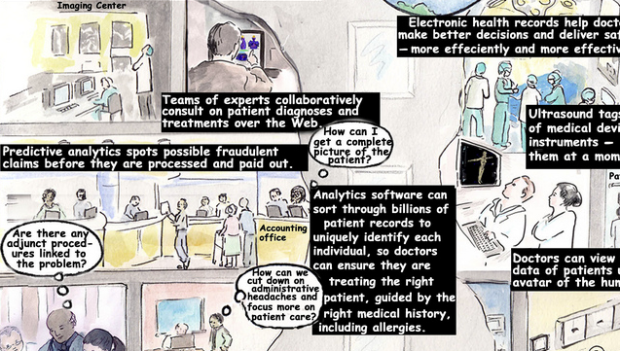My wife is an ER doc, so I hear about this sort of stuff all the time. Hospitals are going all-digital, and the exchange of data from doctor to doctor, from hospital to hospital, from patient to doctor, and doctor to patient is only going to get easier.
This expedited exchange of information will bring advantages such as fewer prescription errors, easier hospital transfers, and through sensors and mobile devices, professional health practitioners will be able to provide better care to those with chronic health conditions. This illustration from Chris Luongo explains a bit more.
Naturally, with all these benefits come plenty of challenges. Data privacy is huge here. Can you imagine if your medical charts ended up in some random hacker’s hands and then sold to the highest bidder? At least we might get more useful spam. I want big discounts on mis-spelled drugs that I actually need.
Seriously though. Data is blowing up, and there’s going to be monster demand for data scientists in the next ten years. See that wagon? Better jump on it while there’s still room.
[via Smarter Planet]



Don’t you worry about random hackers learning about your recent bout of gonorrhea. Fun as it is, the real issue with medical data is when insurance companies start demanding full access to sign you up for coverage.
Pingback: How data will improve health care : DynamicSystems
> My wife is an ER doc
Funny, so’s mine. Data nerds and doctors: made for each other?
it’s a match made in heaven
Pingback: How data will improve health care « BI HELPER – Business Information/Ingelligence Helper
Interoperability is another challenge. Everyone is moving to digital records, but there are many different systems that don’t necessarily work together.
You know who’s really going to get rich on this? The IT contractors that put it all together, then get hired AGAIN when two hospitals or agencies merge and their systems don’t work with each other. It’s the same way IT contractors for the US government make a ton of money (see the Washington Post investigation a few weeks back).
Pingback: How data will improve health care | health
Data entry (and proper form design and navigability) is another challenge. My wife is a nurse, and her colleagues frequently don’t know how to specify real-life challenges in the data-entry system for the patient’s care. The Nurse’s Interface just isn’t as flexible as pen and paper and voice communication between nurses during the change of shift.
I can’t tell you how many times I heard of an unexpected occurrence and that there was no way to enter that into the patient’s record.
A big part of the need that will certainly arise with all this new data is a requirement for the tools that convert between the different formats of data that are created by the different parties involved in the generation of this data.
Doctor myself.
Another gimongous hurdle is getting the data in there in the first place. As it stands now, keeping records is significantly less time-consuming using handwritten notes and orders. Unless systems are designed to make data input as easy (or easier) than old-fashioned pen and paper, the added costs in terms of time and frustration will be insupportable. Many physicians–this is sure to change over the coming decades–cannot type well enough; voice recognition software is not yet up to any task that requires precision (e.g. the kind of precision you want when your notes are blown up and displayed in a court room); and dictation services using humans to transcribe may be prohibitively costly with turn-around times not adequate to the needs of fast-moving services.
Also, I honestly don’t like the illustration. Nathan, you’ve posted things that were failed attempts or bad examples before. What do you consider that illustration above? Does it clearly and and effectively convey its message?
No, it’s just a cartoon. Nothing more, nothing less.
Actually, that’s one of the more disappointing things I’ve seen you write. Isn’t this blog about data and pictures, nothing more nothing less? Are you really no longer interested in the effectiveness of pictures to convey data?
I think it’s far more useful to say, “this illustration was cluttered and ineffective” than to suggest, “hand drawn pictures have no place in conveying serious information, except when they’re clever Venn diagrams on napkins.” (I’m over-stating it, I know.)
Well, no, that’s not what I meant. I think that this was drawn to read like a comic strip, so I’m not looking for information design principles at work here. The napkin drawings, however, were drawn to make concepts easier to understand. So it’s about each illustrations’ purpose.
For this case, I was more interested in the idea of health and data than the illustration itself. Data fanboy, I am and all :)
Have you seen the newest white paper about 5 Strategies for Improving Employee Satisfaction in Healthcare ? I think you might find it interesting..and if your wife is an ER doc, she will too. :o)
Pingback: Discussing data and what you can do with it « Policy and Performance